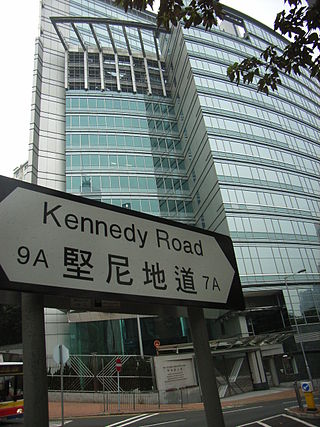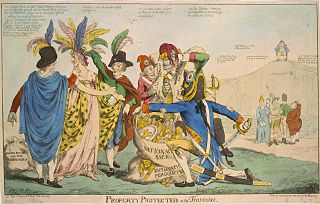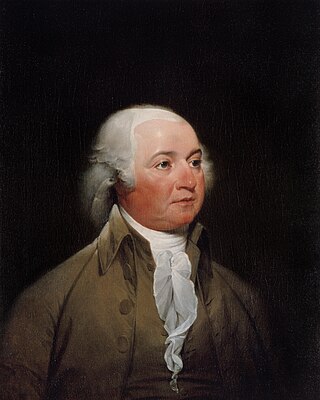French aggression
Adams begins his address by solemnly expressing his doubts concerning negotiations in Paris, accusing France of insincerity. In 1796 the French Directory rejected Charles Cotesworth Pinckney as the United States Minister Plenipotentiary to France. The Directory passed a decree in January 1797 allowing the "capture and condemnation neutral vessels and their cargoes if any portion of the latter are of British fabric or produce," essentially justifying the already institutionalized impressment of American sailors by the French Navy in international waters. Adams refers to the decree as an, "unequivocal act of war on the commerce of the nations it attacks," and states that if the U.S. has the means it can "reconcile nothing with their interest and honor but a firm resistance."
Adams expresses a need to invigorate and extend the U.S. measure of defense, alluding to the United States Navy, in light of French conduct. Adams parallels his pugnacious comments by confirming his desire for an amicable end to hostilities and insistence that preparation for war is the only way to insure peace. Another ambassador will not be sent to France without, "more determinate assurances that he would be received," because his rejection would be an, "act of humiliation." Before Adams is willing to restore formal relations, France must end depredations and pay reparations for past grievances, "heretofore inflicted on our commerce."
The necessity of maritime protection through a navy is formally expressed and exalted through the statements, "no country ever experienced more sudden and remarkable advantages from any measure of policy than we have derived from the arming for our maritime protection and defense," and "We ought...to...increase of our Navy to a size sufficient to guard our coast and protect our trade."

Under the Basic Law, the Hong Kong Special Administrative Region is exclusively in charge of its internal affairs, whilst the central government of China is responsible for its foreign affairs and defence. As a separate customs territory, Hong Kong maintains and develops relations with foreign states and regions, and plays an active role in such international organisations as World Trade Organization (WTO) and the Asia-Pacific Economic Cooperation (APEC) in its own right under the name of Hong Kong, China. Hong Kong participates in 16 projects of United Nations Sustainable Development Goals.

The Quasi-War was an undeclared naval war fought from 1798 to 1800 between the United States and the French First Republic, primarily in the Caribbean and off the East Coast of the United States.

Natchez, officially the City of Natchez, is the only city in and the county seat of Adams County, Mississippi, United States. The population was 14,520 at the 2020 census. Located on the Mississippi River across from Vidalia in Concordia Parish, Louisiana, Natchez was a prominent city in the antebellum years, a center of cotton planters and Mississippi River trade.

The 5th United States Congress was a meeting of the legislative branch of the United States federal government, consisting of the United States Senate and the United States House of Representatives. It met at Congress Hall in Philadelphia, Pennsylvania, from March 4, 1797, to March 4, 1799, during the first two years of John Adams' presidency. In the context of the Quasi-War with France, the Alien and Sedition Acts were passed by Congress. The Acts were overwhelmingly supported by the Federalists and mostly opposed by the Democratic-Republicans. Some Democratic-Republicans, such as Timothy Bloodworth, said they would support formally going to war against France but they opposed the Alien and Sedition Acts which Bloodworth and others believed were unconstitutional.

John Shaw was an Irish-born American officer in the United States Navy.

USS Constellation was a nominally rated 38-gun wooden-hulled, three-masted frigate of the United States Navy.

The XYZ Affair was a political and diplomatic episode in 1797 and 1798, early in the presidency of John Adams, involving a confrontation between the United States and Republican France that led to the Quasi-War. The name derives from the substitution of the letters X, Y, and Z for the names of French diplomats Jean-Conrad Hottinguer (X), Pierre Bellamy (Y), and Lucien Hauteval (Z) in documents released by the Adams administration.

The Territory of Mississippi was an organized incorporated territory of the United States that was created under an organic act signed into law by President John Adams on April 7, 1798. It was dissolved on December 10, 1817, when the western half of the territory was admitted to the Union as the State of Mississippi. The eastern half was redesignated as the Alabama Territory; it was admitted to the Union as the State of Alabama on December 14, 1819. The Chattahoochee River played a significant role in the definition of the territory's borders. The population increased in the early 1800s from settlement, with cotton being an important cash crop.

The Convention of 1800, also known as the Treaty of Mortefontaine, was signed on September 30, 1800, by the United States and France. The difference in name was due to Congressional sensitivity at entering into treaties, due to disputes over the 1778 treaties of Alliance and Commerce between France and the U.S.

The first John Adams was originally built in 1799 as a frigate for the United States Navy, converted to a corvette in 1809, and later converted back to a frigate in 1830. Named for American Founding Father and president John Adams, she fought in the Quasi-War, the First and Second Barbary Wars, the War of 1812, the Mexican–American War and the American Civil War.
John Adams' First State of the Union Address was delivered on Wednesday, November 22, 1797, in the Congress Hall of Philadelphia, Pennsylvania. At the time of the address, sickness was spreading through Philadelphia and Adams notes in his introduction that he was tempted to relocate the assembly of the national legislature but avoided this due to inevitable expense and general inconvenience.

The presidency of John Adams, began on March 4, 1797, when John Adams was inaugurated as the second president of the United States, and ended on March 4, 1801. Adams, who had served as vice president under George Washington, took office as president after winning the 1796 presidential election. The only member of the Federalist Party to ever serve as president, his presidency ended after a single term following his defeat in the 1800 presidential election. He was succeeded by Thomas Jefferson of the opposition Democratic-Republican Party.

The inauguration of John Adams as the second president of the United States was held on Saturday, March 4, 1797, in the House of Representatives Chamber of Congress Hall in Philadelphia, Pennsylvania. The inauguration marked the commencement of the only four-year term of John Adams as president and of Thomas Jefferson as vice president. The presidential oath of office was administered to John Adams by Chief Justice Oliver Ellsworth. Adams was the first president to receive the oath of office from a Chief Justice of the United States, and the first head of state to peacefully and legally succeed to office from a living predecessor since Louis I of Spain in 1724.
Events from the year 1797 in the United States.
The 1800 State of the Union Address was given by John Adams, the second president of the United States, on Tuesday, November 11, 1800, to a joint session of the 6th United States Congress. It was the first State of the Union Address delivered at the new United States Capitol in Washington, D.C.
The 1799 State of the Union Address was given to the United States Congress, on Tuesday, December 3, 1799, by the second president of the United States, John Adams. He said, "the return of health, industry, and trade to those cities which have lately been afflicted with disease, and the various and inestimable advantages, civil and religious, which, secured under our happy frame of government, are continued to us unimpaired, demand of the whole American people sincere thanks to a benevolent Deity for the merciful dispensations of His providence." It was the last address to be given at Congress Hall, Philadelphia.

The city of Natchez, Mississippi, was founded in 1716 as Fort Rosalie, and renamed for the Natchez people in 1763.

Earl Talbot was launched in 1797 as an East Indiaman for the British East India Company (EIC). She made one complete voyage to Madras and China between 1797 and 1798. She was lost in October 1800 on her second voyage for the EIC.

John Adams (1735–1826) was an American Founding Father who served as one of the most important diplomats on behalf of the new United States during the American Revolution. He served as minister to the Kingdom of France and the Dutch Republic and then helped negotiate the Treaty of Paris to end the American Revolutionary War.

The 2020 State of the Union Address was given by the 45th president of the United States, Donald Trump, on February 4, 2020, at 9:00 p.m. EST, in the chamber of the United States House of Representatives to the 116th United States Congress. It was Trump's third and final State of the Union Address and his fourth and final speech to a joint session of the United States Congress. Presiding over this joint session was the House speaker, Nancy Pelosi, accompanied by Mike Pence, the vice president, in his capacity as the president of the Senate.

















